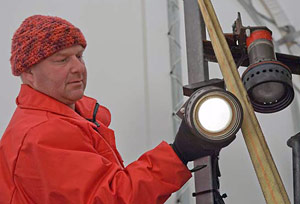|
Interview with Tim Shank : Part 2 by Lonny Lippsett, photo by Chris Linder 
WHOI biologist Tim Shank tests a light on the Camper vehicle, getting it prepared for missions to photograph and sample rocks and animal life around hydrothermal vents, if we find any. What are some other interesting features of the Gakkel Ridge that might affect what life forms you find there? Mantle rock has a different chemical composition from volcanic rock, or basalt, which we usually see on mid-ocean ridges. When mantle rock reacts with seawater, it produces different chemicals. These are the kinds of conditions that we think were present on the early Earth. So the microbes at Gakkel Ridge vents may be living relics of those that existed when Earth was young. That leads us think about the origin of life on this planet. And also to life on other planetary bodies, true? What are your plans if you find vents on the Gakkel Ridge? The next thing is look at their genes. I hope to bring animals back to the lab, extract and sequence their DNA—their genetic material—and compare it to other DNA we have from other vent animals around the world. We’d like to see, for example, if the Arctic vent animals are more closely related to Atlantic-type fauna or Pacific-type fauna. We can look at whether Arctic Ocean life might have migrated from the Atlantic or the Pacific. Or we might discover that their closest evolutionary relative is only in the fossil record. Or we might find something totally new. What we can do with the DNA is reconstruct the past and see how these species have diverged from species that we know about today. And so we’ll put pieces of the global evolutionary puzzle together to get a sense of how life has evolved in vent systems. What is your biggest hope about the expedition? What is your worst fear about the expedition? But, if we learn something from looking at the Gakkel Ridge and going under the ice, and apply it to other places on Earth, or other planets or moons, that’s also a real positive. What do you like best about your job? When I was growing up, I remember reading about Magellan and Vasco da Gama, and those guys, and I was disappointed because the age of exploration, the age of discovery, seemed over. They’d already found all the continents. Well, the truth is there’s so much more on our Earth to discover, that it’ll never be done in my lifetime or ten more lifetimes. Less than two percent of our mid-ocean ridge system has been explored! We really have yet to see the diversity that’s out there, given how little we’ve looked. It’s going to be a thrill to get those animals on the Gakkel Ridge. If we do. Page [ 1 ] [ 2 ]
|
Mailing List | Feedback | Glossary | For Teachers | About Us | Contact
© 2010 Dive and Discover™. Dive and Discover™ is a registered trademark of Woods
Hole Oceanographic Institution
